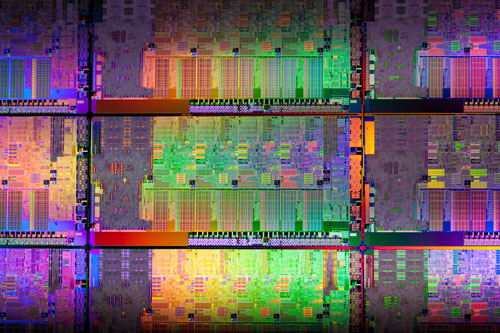| Posted: Apr 01, 2011 | |
Nanoelectronics experiment in the Vatican results in unexplicable phenomena |
|
| (Nanowerk Spotlight) It started innocently enough with isolated instances of smoke coming out of computers. Then networks crashed. Now, programs are malfunctioning on a large scale, shutting down the Vatican's huge computer infrastructure which it depends on to manage its billions upon billions of investment dollars, real estate portfolios, and art collections. | |
| It is difficult to obtain all the details, but it appears that some form of nanotechnology got out of control. Surprisingly, and against its deeply ingrained reflexes of total openness and transparency, the Vatican initially tried to cover the whole thing up. Until a tabloid reporter got wind of what had happened and the whole thing became public with an article today (April 1) in an Italian tabloid that had this sensation-seeking headline splashed all over the front page: Gay nanobots ballano Bunga-Bunga in Vaticano - Gay nanobots dance Bunga-Bunga in the Vatican. | |
| Of course, you'll say: "Baloney! There are no gay nanobots; there even isn't any nanorobotics to speak of. And this Bunga-Bunga stuff is strictly Berlusconi territory." Well, that's what we thought – until we spoke with an Italian undercover reporter who closely follows the goings-on in the Vatican. | |
| It seems that something weird is happening deep inside the Church's electronic infrastructure – and it has to do with leading-edge nanotechnology. | |
| Not surprisingly, some of the more conservative members of the Catholic clergy welcome these technical problems as a good thing. They think that science and technology have had a devastating impact on the Church's influence on society. Starting with the printing press, it became increasingly difficult to cover up abusive behavior. Not to mention people's ability to get educated and strive for science-based explanations of the world around them. | |
| This is, after all, an organization that took almost 400 years to pardon Galileo Galilei after the Inquisition accused him of heresy for claiming that the Earth moves around the Sun (in 1992, three years after Galileo's namesake spacecraft had been launched on its way to Jupiter, the Vatican formally cleared him of any wrongdoing and admitted that his heliocentric theory was correct). E pur si muove! | |
| But we digress. From various reports and background interviews with scientists at the respected Italian Institute of Technology (ITT), we were able to piece together what has happened so far: | |
| While on the outside they foster a very conservative and traditional image, the Catholic Church actually is using cutting-edge technology to run its vast operations; they even are actively pursuing highly experimental and not yet commercially available technology. One psychologist said that this is a classical example of overcompensating a whiff off guilt stemming from "that inquisition business centuries ago". | |
 |
|
| The secretive supercomputer center somewhere inside Vatican City. | |
| In an attempt to outdo Wall Street quants and generate better returns on its investments, the Vatican's IT department – the Centro Elaborazione Dati, which is shown as a deceptively simple outfit on the Vatican's website – secretly approved a revolutionary experiment supported by nanoelectronics specialists to develop sophisticated trading programs for its investment portfolio. Apparently, these researchers modeled their approach on the ambitious DARPA sponsored SyNAPSE (Systems of Neuromorphic Adaptive Plastic Scalable Electronics) project. The goal is to develop electronic neuromorphic machine technology that scales to biological levels. Other nanotechnology research groups are trying to build computers modeled after the brain, integrate computer chips inside living cells, or even integrate living brain cells into organic semiconductors. | |
| Over a long pasta lunch, the experiment got out of control. Although intelligently designed, the totally unexpected results were semi-autonomous and mobile nanoscale assemblies that consist of a organic/inorganic composite of brain cells and semiconductor material. The researchers call them "Nanoscale Morphing Robotic Assemblies" - or Nanomorass, as they were nicknamed by the team. They proved to be highly adaptable to environmental stimuli, were able to assemble additional units on their own, and had a learning capability that made them appear almost self-aware. | |
| But contrary to popular sci-fi culture ('replicators') they don't just self-assemble by assimilating stuff, they need to exchange programming code and they do that by linking their assembler nodes together - apparently there are male and female versions of these nodes; pretty much like with cables or pipes where each half of a pair of mating connectors or fasteners is conventionally assigned the designation male or female. | |
| While observing the Nanomorass under an atomic force microscope, the scientists were startled by their weird – almost ritualistic – behavior. | |
| "If I hadn't seen it with my own eyes I wouldn't believe it" says a senior ITT researcher. "We observed instance where these nanostructures were rotating in almost dance-like moves across the silicon substrates of computer chips. This was clearly more organized than just simply van der Waals forces overcoming Brownian motion and it surely felt very purposeful and deliberate." | |
 |
|
| Experimental computer chip on which the Nanomorass are running free. | |
| He continued: "Strangely enough, these were only the 'male' versions of the nanobots. When we tried to find out what had happened to the 'female' versions, we couldn't find any!" | |
| One hypothesis is based on the environmental impact on the bots' programming: "Somehow their code has adapted to eradicate the female versions," says our source inside the Vatican. "Our best explanation is that, since they had access to the video feed from the webcams inside the Vatican as well as the huge digital library with all historic documents, they learned from this information and created their own version of what they perceive to be a normal society based on their surroundings." | |
| Far from living a live of 'nanocelibacy', so to speak, the all-male nanobot population is still engaging in extensive replication activities. The dilemma for the Church, as one moral theologian put it, is that you now have something that can be called homosexual behavior taking place inside the Vatican. "That of course is something totally inconceivable and comes as a huge shock to all of us, as you can imagine." | |
| "We are not claiming that homosexuality is a sin," notes one senior Cardinal, "but a more or less strong tendency ordered toward an intrinsic moral evil and thus an objective disorder. Even among nanobots." His, and his colleagues' conclusion therefore has been to put an end to this nanoscale debauchery. | |
| The dilemma for the Vatican is that, since the Nanomorass contain human cells, simple eradication through virus crusaders is out of the question. "That would have been perfectly OK a few hundred years ago, but now, unfortunately, we are not writing the rules anymore." | |
| "We also cannot approve of any preventive technical measures that would keep these little amoral bastards from replicating since that would be against the natural order," he says. "These nanobots need to be reprogrammed or otherwise convinced that self-control is the best course of action." | |
| New documents show that the Vatican has known for many years about quite a number of cases where computers have malfunctioned due to errant nanobot behavior. In the interest of the greater good of the Church, these cases were dealt with internally though, and experienced external specialists were not informed or asked to assist in dealing with the problem. | |
| "We had cases where infected computers were simply disconnected from a particular network and moved to a different network in the hope that they would function normally again," said one member of the Vatican IT Guard who is also responsible for monitoring computer security at the Vatican. "After all, this strategy worked so well in other circumstances. Sadly, this time it didn't." | |
| As for the "Bunga-Bunga parties", researchers have now concluded that the Nanomorass are clearly self-organizing and even have established something like a - albeit primitive – society with a leader that the scientists call "Silvio". | |
| "But their 'moral behavior', if you may call it that, is more along the lines of Confucian respect for social harmony than the Catholic dogma of guilt and banning the fun things in life," says one scientist. "Sometimes they just like to have a good time, with no discernible purpose whatsoever," he adds. "That includes acts of what only could be called recreational sex." | |
 |
|
| Nanowire arrays in flames | |
| Oh, and the smoke coming out of the computers? Well, it appears there is a darker explanation for that...: Once they noticed that all female nanobots had gone missing, the nanoscientists tried to figure out what had happened. From the evidence they were piecing together it appears that one night all female Nanomorass ended up attached to nanowire arrays and then simply evaporated after overheating. "If it didn't sound so weird, I'd say they were burned at the stake," says our source. "Of course, there's gotta be a scientific explanation, we just haven't found it yet." | |
| By Angelo Tuttifrutti (reporting for Nanowerk from deep inside the Vatican) | |
|
Become a Spotlight guest author! Join our large and growing group of guest contributors. Have you just published a scientific paper or have other exciting developments to share with the nanotechnology community? Here is how to publish on nanowerk.com. |
|
